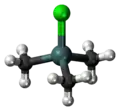Trimethyltin chloride
Trimethyltin chloride is an organotin compound with the formula (CH3)3SnCl. It is a white solid that is highly toxic and malodorous. It is susceptible to hydrolysis.
| |||
| Names | |||
|---|---|---|---|
| Other names
chlorotrimethylstannane; chlorotrimethyltin; trimethyl chlorostannane; trimethylchlorotin; trimethylstannyl chloride; trimethyltin monochloride | |||
| Identifiers | |||
3D model (JSmol) |
|||
| ChemSpider | |||
| ECHA InfoCard | 100.012.653 | ||
PubChem CID |
|||
| UNII | |||
CompTox Dashboard (EPA) |
|||
| |||
| |||
| Properties | |||
| C3H9SnCl | |||
| Molar mass | 199.27 g/mol | ||
| Melting point | 38.5 °C (101.3 °F; 311.6 K)[1] | ||
| Boiling point | 148 °C (298 °F; 421 K) | ||
| Hazards | |||
| Safety data sheet | External MSDS | ||
| R-phrases (outdated) | 26/27/28-50/53 | ||
| S-phrases (outdated) | 26-27-28-45-60-61 | ||
Except where otherwise noted, data are given for materials in their standard state (at 25 °C [77 °F], 100 kPa). | |||
| Infobox references | |||
Synthesis
Trimethyltin chloride can be prepared by the redistribution reaction of tetramethyltin with tin tetrachloride.[2]
- SnCl4 + 3 SnMe4 → 4 Me3SnCl
This is the Kocheshkov redistribution reaction. It is performed under an inert atmosphere, such as argon, typically with no solvent.
A second route to Me3SnCl involves treating the corresponding hydroxide or oxide with a halogenating agent such as hydrogen chloride or thionyl chloride (SOCl2):
- Me3SnOH + HCl → Me3SnCl + H2O
Uses
Trimethyltin chloride is used as a source of the trimethylstannyl group.[3] For example, it is a precursor to vinyltrimethylstannane and indenyltrimethylstanane:[4]
- CH2=CHMgBr + Me3SnCl → Me3SnCH=CH2 + MgBrCl
- LiC9H7 + Me3SnCl → Me3SnC9H7 + LiCl
An example of an organolithium reagent reacting with Me3SnCl to form a tin-carbon bond is:
- LiCH(SiMe3)(GeMe3) + Me3SnCl → Me3SnCH(SiMe3)(GeMe3) + LiCl
Organotin compounds derived from Me3SnCl are useful in organic synthesis, especially in radical chain reactions. Me3SnCl is a precursor to compounds used in PVC stabilization. Reduction of trimethyltin chloride gives tin-tin bonds.
- Me3SnM + Me3SnCl → Sn2Me6 + MCl (M = metal)
References
- Lide, D. R.; Milne, G. W. (1994). Handbook of Data on Organic Compounds. 4 (3rd ed.). CRC Press. p. 4973.
- Scott, W. J.; Crisp, G. T.; Stille, J. K. (1990). "Palladium-catalyzed Coupling of Vinyl Triflates with Organostannanes: 4-tert-Butylcyclohexen-1-yl)-2-propen-1-one". Organic Syntheses. 68: 116.CS1 maint: multiple names: authors list (link); Collective Volume, 8, p. 97
- Davies, A. G. (2008). "Tin Organometallics". Comprehensive Organometallic Chemistry. 3. Elsevier. pp. 809–883. doi:10.1016/B0-08-045047-4/00054-6. ISBN 9780080450476.
- Robert J. Morris, Scott L. Shaw, Jesse M. Jefferis, James J. Storhoff, Dean M. Goedde (2007). "Monoindenyltrichloride Complexes of Titanium(IV), Zirconium(IV), and Hafnium(IV)". Inorganic Syntheses. Inorg. Synth. Inorganic Syntheses. 32. pp. 215–221. doi:10.1002/9780470132630.ch36. ISBN 9780470132630.CS1 maint: uses authors parameter (link)

